The 1988 Volkswagen Westfalia Camper, a timeless icon of adventure and freedom, represents a golden era of road-tripping and van life. This meticulously engineered vehicle, built on the sturdy foundation of the Volkswagen Transporter, embodies a unique blend of practicality and style.
With its signature pop-up roof, compact yet functional interior, and a spirit of exploration, the 1988 Westfalia Camper became a symbol of the carefree lifestyle embraced by countless adventurers. From its origins in the 1950s, the Westfalia Camper has evolved into a cultural phenomenon, capturing the imaginations of generations with its ability to transform ordinary journeys into extraordinary experiences.
The 1988 model, in particular, stands out for its distinctive features, including a refined interior with enhanced comfort and a more powerful engine that provided a smoother driving experience. Its ability to seamlessly transition from a daily driver to a comfortable living space made it a popular choice for families, couples, and solo travelers alike.
Whether exploring scenic landscapes, attending music festivals, or simply escaping the daily grind, the 1988 Westfalia Camper offered a unique blend of practicality and adventure.
History and Background
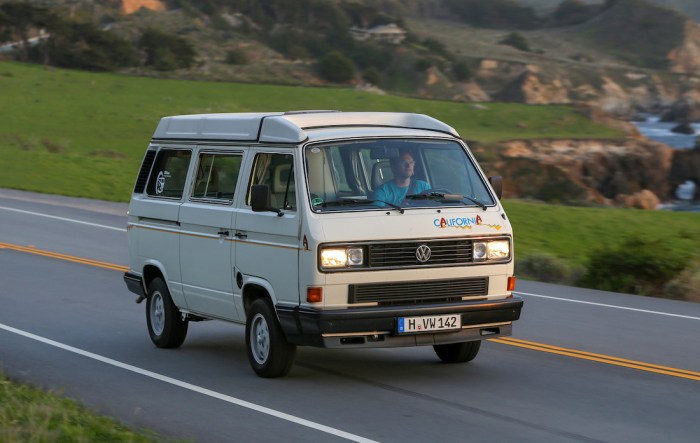
The Volkswagen Westfalia Camper, affectionately known as the “Westfalia,” is a legendary vehicle that embodies the spirit of freedom and adventure. The 1988 model, specifically, holds a special place in the hearts of enthusiasts, representing a pinnacle of design and functionality.
This model is a testament to the enduring legacy of the Westfalia Camper, a legacy that spans over six decades and continues to inspire wanderlust in generations.The origins of the Westfalia Camper can be traced back to the early 1950s, when the Volkswagen Type 2, also known as the “Transporter,” was first introduced.
The Type 2’s versatility and affordability made it an instant success, and soon, German coachbuilder Westfalia began converting these vans into mobile homes. The partnership between Volkswagen and Westfalia marked the birth of the iconic Westfalia Camper.
Evolution of the Westfalia Camper
The 1988 Westfalia Camper, based on the Volkswagen T3 (Type 2) chassis, represents a significant milestone in the evolution of the Westfalia Camper. The T3 model introduced several improvements over its predecessors, including a more powerful engine, a more spacious interior, and enhanced safety features.
The 1988 Westfalia Camper, like its predecessors, was designed to provide a comfortable and practical living space for travelers. The interior featured a pop-up roof, a fold-down bed, a kitchenette, and a dining table, all ingeniously integrated into a compact space.
This innovative design allowed the 1988 Westfalia Camper to offer a unique blend of functionality and comfort, making it a popular choice for families, couples, and individuals seeking an adventurous lifestyle.
Key Features and Design Elements
The 1988 Westfalia Camper’s popularity can be attributed to its numerous key features and design elements that made it a standout vehicle. These included:
- Pop-up roof:The pop-up roof provided additional headroom and sleeping space, transforming the interior into a spacious living area.
- Fold-down bed:The bed, cleverly concealed within the van’s interior, could be easily converted into a comfortable sleeping area for two or three people.
- Kitchenette:The kitchenette featured a sink, a two-burner stove, and storage space for cookware and utensils, allowing travelers to prepare their own meals on the road.
- Dining table:The dining table, which could be folded away when not in use, provided a convenient space for meals and social gatherings.
- Spacious interior:The 1988 Westfalia Camper’s interior was designed to maximize space and functionality, making it feel surprisingly roomy despite its compact size.
Historical Anecdotes
The 1988 Westfalia Camper has been featured in numerous movies, TV shows, and documentaries, solidifying its place in pop culture. It has been a favorite among surfers, artists, and musicians, representing a symbol of freedom and adventure.
“The Westfalia Camper is more than just a vehicle; it’s a lifestyle. It’s about embracing simplicity, exploring the world, and creating memories that will last a lifetime.”
Unknown
Design and Features
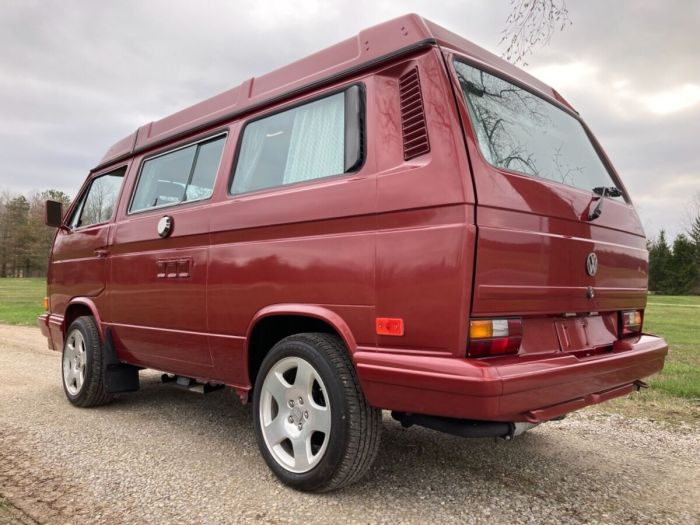
The 1988 Volkswagen Westfalia Camper is a classic example of German engineering and design, blending functionality with a sense of adventure. It features a distinctive exterior, a spacious and versatile interior, and a range of innovative features that made it a popular choice for camping enthusiasts.
The 1988 Volkswagen Westfalia Camper, a symbol of freedom and adventure, embodies the spirit of its iconic predecessor, the 1950 Volkswagen Beetle. Both vehicles share a legacy of practicality and affordability, making them accessible to those seeking a unique and fulfilling travel experience.
While the Westfalia Camper offers a more modern and spacious living space, it retains the same charm and character that made the Beetle a global phenomenon.
Exterior Design
The 1988 Westfalia Camper is based on the Volkswagen Transporter T3 chassis, a van known for its ruggedness and reliability. Its exterior design is characterized by its boxy shape, high roofline, and distinctive front grille. The van’s overall dimensions are compact, making it easy to maneuver on narrow roads and in tight spaces.
The exterior paint options typically included a range of colors, from classic white to vibrant blues and reds.
Interior Design
The interior of the 1988 Westfalia Camper is designed to maximize space and comfort. The front cabin features two captain’s chairs that swivel to face the rear living area, creating a social space. The rear living area features a variety of amenities, including a fold-down table, a kitchenette with a sink and stovetop, and a comfortable sleeping area.
The pop-up roof, a signature feature of the Westfalia Camper, provides additional headroom and sleeping space.
Pop-Up Roof
The pop-up roof is a defining feature of the 1988 Westfalia Camper. It allows for extra headroom and sleeping space, transforming the van into a spacious living area. The roof is typically made of fiberglass and can be raised and lowered manually.
It also features a built-in ventilation system to ensure proper airflow and prevent condensation.
Sleeping Arrangements
The 1988 Westfalia Camper offers a variety of sleeping arrangements to accommodate up to four people. The rear bench seat converts into a double bed, and the pop-up roof provides an additional sleeping area for two. The van also features a fold-down bed above the cab area, offering another sleeping option.
Kitchen Amenities
The 1988 Westfalia Camper is equipped with a compact but functional kitchenette. It includes a sink, a two-burner stovetop, and a refrigerator. The kitchenette is typically located at the rear of the van and features a countertop that can be used for food preparation and dining.
Comparison with Earlier and Later Models
The 1988 Westfalia Camper is a transitional model, bridging the gap between the earlier T2 and the later T4 generations. Compared to the T2, the T3 offers a more modern interior design, improved engine performance, and more advanced features. However, it lacks the retro charm and classic appeal of the T2.
Compared to the T4, the T3 is considered to be more rugged and less sophisticated. It features a simpler interior design and fewer amenities, but it retains the classic Westfalia Camper feel.
Performance and Handling: 1988 Volkswagen Westfalia Camper
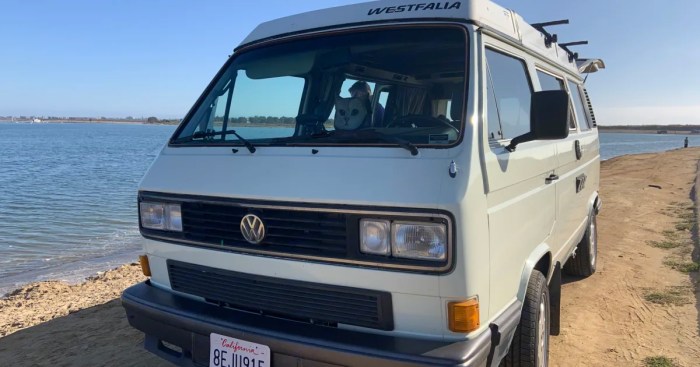
The 1988 Volkswagen Westfalia Camper, while known for its versatility and comfort, isn’t renowned for its sporty performance. It’s a vehicle designed for leisurely travel and practicality, not for racing or high-speed maneuvering.
Engine Specifications and Performance
The 1988 Westfalia Camper was powered by a 2.1-liter, water-cooled, four-cylinder gasoline engine. This engine produced 90 horsepower and 114 lb-ft of torque. The engine was paired with a four-speed manual transmission or a three-speed automatic transmission. The camper’s performance was adequate for its intended use, but it was not particularly fast or powerful.
Driving Experience
The 1988 Westfalia Camper offered a comfortable and relaxed driving experience. The suspension was designed for comfort rather than handling, which resulted in a soft and forgiving ride. The steering was light and responsive, but it lacked precision and feedback.
The camper’s high roof and large size contributed to a somewhat cumbersome feel, especially when navigating tight corners or windy roads.
Comparison to Other Vehicles
The 1988 Westfalia Camper’s performance was comparable to other camper vans of its time. Vehicles like the Ford Econoline and Chevrolet G-Series offered similar power and handling characteristics. However, the Westfalia Camper was generally considered to be more comfortable and spacious than its competitors.
Living Experience
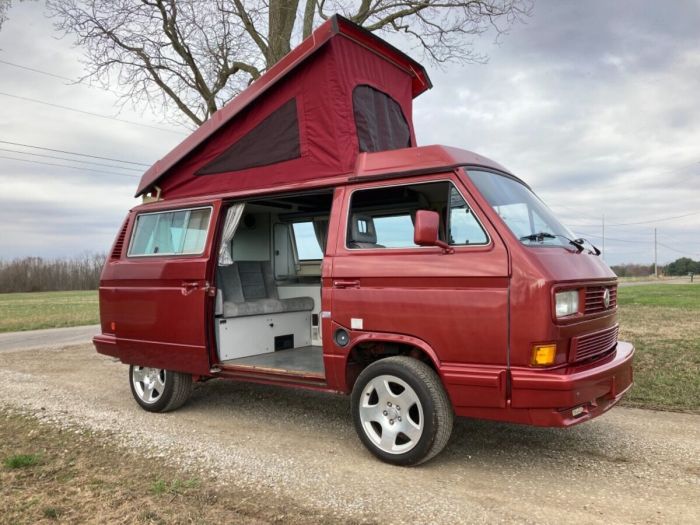
Stepping inside the 1988 Westfalia Camper is like stepping into a time capsule, offering a unique blend of retro charm and practical functionality. The camper’s interior is a testament to its dual purpose: serving as both a cozy home on the road and a versatile space for daily living.
Space and Comfort
The camper’s compact size, while efficient for maneuverability, creates a sense of intimacy within the living space. The pop-up roof adds valuable vertical space, maximizing headroom and creating a more spacious feel. The Westfalia’s layout prioritizes functionality, utilizing every inch effectively.
The front seats swivel to face the rear, transforming the cabin into a living area. The rear bench folds down into a bed, providing a comfortable sleeping space for two. The camper’s design incorporates clever storage solutions, maximizing space utilization.
Amenities
The 1988 Westfalia Camper is equipped with essential amenities for comfortable living on the road. These features enhance the overall living experience and provide a sense of self-sufficiency.
Key Living Features
| Feature | Benefit |
|---|---|
| Pop-up roof | Provides additional headroom and ventilation. |
| Swiveling front seats | Creates a spacious living area when facing the rear. |
| Folding rear bench | Transforms into a comfortable double bed. |
| Built-in sink and stove | Allows for basic food preparation and cleaning. |
| Refrigerator | Provides cold storage for food and beverages. |
| Storage compartments | Maximizes space utilization and keeps belongings organized. |
Maintenance and Repair
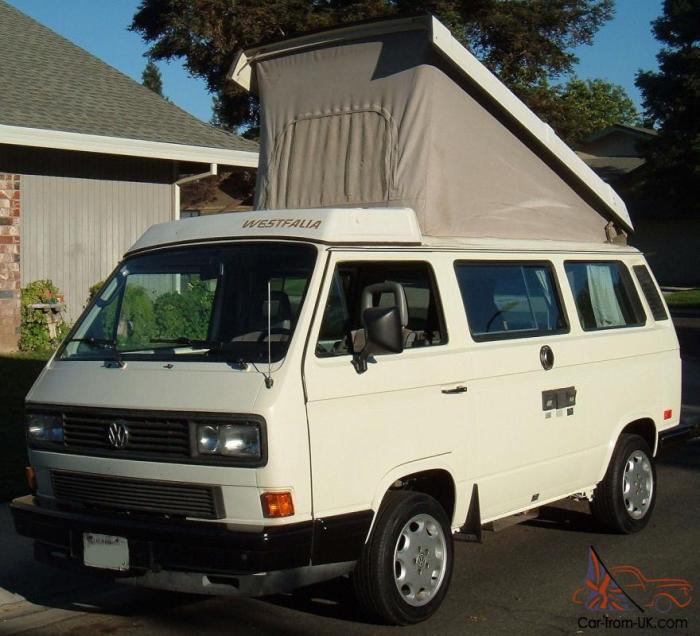
Owning a 1988 Westfalia Camper, like any classic vehicle, involves a commitment to regular maintenance and occasional repairs. This section will guide you through common procedures and potential issues, equipping you with the knowledge to keep your Westfalia running smoothly and reliably.
The 1988 Volkswagen Westfalia Camper, with its iconic pop-top roof and cozy interior, remains a classic for a reason. Its timeless design and practicality continue to attract enthusiasts, much like the later models, such as the 2000 Volkswagen Van , which offered a more modern take on the same spirit of adventure.
While the 2000 model brought new features and technology, the 1988 Westfalia retains its nostalgic charm, reminding us of simpler times and the joy of hitting the open road.
Common Maintenance Procedures
The 1988 Westfalia Camper, being a vehicle with both mechanical and living space components, requires a multifaceted approach to maintenance. Regular checks and scheduled servicing ensure longevity and prevent unexpected breakdowns.
- Engine Maintenance:The heart of your Westfalia is its engine. Regular oil changes, air filter replacements, and spark plug inspections are essential. Refer to the owner’s manual for recommended service intervals.
- Cooling System:Ensure the cooling system is functioning correctly by checking the coolant level and condition. Inspect the hoses for leaks and ensure the radiator fan is operating.
- Brakes:Brake pads and rotors wear over time. Check the thickness of the brake pads and inspect the rotors for wear or damage.
- Tires:Regularly inspect tire pressure and tread depth. Ensure tires are properly inflated and have sufficient tread for safe driving.
- Electrical System:Check the battery terminals for corrosion and ensure the charging system is functioning correctly. Inspect all lights and electrical components for proper operation.
- Living Space:Maintain the interior of your Westfalia by regularly cleaning the upholstery, cabinets, and appliances. Inspect the water system, including the fresh and waste water tanks, for leaks and proper functionality.
Potential Repairs
While preventative maintenance minimizes the need for repairs, some issues may arise over time. Recognizing common problems and understanding potential solutions can help you address them effectively.
The 1988 Volkswagen Westfalia Camper is a classic for a reason – its blend of practicality and adventure is hard to beat. If you’re looking for a more utilitarian Volkswagen, the 1971 Volkswagen Double Cab is a solid choice. With its spacious bed and rugged build, it’s perfect for hauling gear and tackling tough terrain.
But for a truly iconic experience, the 1988 Westfalia Camper remains the ultimate symbol of freedom on the open road.
- Engine Problems:Issues like engine misfires, overheating, or excessive oil consumption can occur. These often require diagnosing the underlying cause, which may involve replacing spark plugs, sensors, or even major engine components.
- Transmission Issues:Transmission problems, such as slipping gears or rough shifting, may require adjustments or even a complete transmission overhaul.
- Suspension Issues:Worn suspension components, such as shocks, struts, or ball joints, can cause handling problems and a rough ride. Replacing these parts can restore proper handling and comfort.
- Body and Paint:Over time, the body and paint of your Westfalia may show signs of wear and tear. This can be addressed through minor repairs, repainting, or rust prevention measures.
- Living Space Issues:Problems with appliances, plumbing, or electrical systems in the living space may arise. Troubleshooting and repairs often involve specific knowledge of the camper’s design and components.
Parts and Resources, 1988 Volkswagen Westfalia Camper
Finding parts for a 1988 Westfalia Camper can be a rewarding journey for enthusiasts. Several resources are available for sourcing both original and aftermarket components.
- Volkswagen Dealers:While some parts may be discontinued, Volkswagen dealerships can still be a valuable source for original components.
- Specialty Parts Suppliers:Several companies specialize in supplying parts for classic Volkswagen vehicles, including Westfalia campers. These suppliers often offer a wide range of options, including original, aftermarket, and even reconditioned parts.
- Online Marketplaces:Websites like eBay, Craigslist, and specialized online forums for Volkswagen enthusiasts offer a vast marketplace for finding used and new parts.
- Westfalia Clubs and Forums:Joining Westfalia clubs and forums connects you with a community of passionate owners who share knowledge, resources, and parts.
Tips for Maintaining Your Westfalia
- Regular Inspections:Regularly inspecting your Westfalia for potential issues is crucial. Pay attention to any unusual noises, leaks, or performance changes.
- Preventative Maintenance:Following the recommended maintenance schedule Artikeld in the owner’s manual helps prevent major problems.
- Quality Parts:Using high-quality parts during repairs ensures longevity and reliable performance.
- Documentation:Keeping detailed records of all maintenance and repairs is essential for future reference.
- Professional Help:For complex repairs or issues you’re not comfortable addressing, seeking professional help from a qualified mechanic is recommended.
Culture and Community
The Volkswagen Westfalia Camper, particularly the 1988 model, has transcended its status as a mere vehicle, becoming a cultural icon and a symbol of freedom, adventure, and a unique lifestyle. It has fostered a vibrant community of enthusiasts who share a deep passion for this iconic van.
The Westfalia Camper’s Cultural Significance
The 1988 Westfalia Camper embodies the spirit of the 1980s, a decade characterized by a sense of optimism, exploration, and a desire to break free from conventional norms. It represented a departure from the traditional family vacation, offering a more independent and adventurous way to travel.
This spirit of adventure and self-reliance resonated with a generation seeking to escape the pressures of modern life and reconnect with nature.
The Westfalia Camper Community
The Westfalia Camper community is a testament to the enduring appeal of this iconic vehicle. Enthusiasts from all walks of life share a common passion for the Westfalia, its history, and the unique experiences it offers. This community is active online and offline, with dedicated forums, social media groups, and organized rallies and events.
Westfalia Camper in Pop Culture
The 1988 Westfalia Camper has made numerous appearances in pop culture, solidifying its status as a cultural icon. It has been featured in movies such as “National Lampoon’s Vacation” (1983), where it serves as a symbol of family escapades and misadventures, and “Little Miss Sunshine” (2006), where it represents a journey of self-discovery and family bonding.
The Westfalia has also been featured in television shows, music videos, and literature, further cementing its place in popular culture.
Collecting and Restoration
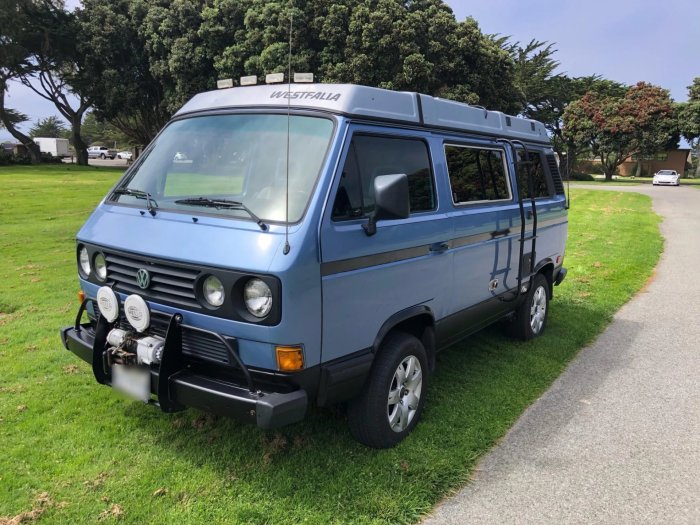
Collecting and restoring a 1988 Volkswagen Westfalia Camper is a labor of love that involves a mix of passion, patience, and a good dose of mechanical know-how. These iconic vehicles are increasingly sought after by enthusiasts, making the process of finding a suitable candidate a crucial first step.
Evaluating the Condition of a 1988 Westfalia Camper
Before embarking on the journey of restoration, it’s essential to thoroughly evaluate the condition of the Westfalia Camper. A comprehensive inspection can save you time, money, and headaches in the long run.
- Body and Paint:Examine the body for rust, dents, and scratches. Check the paint for fading, peeling, or any signs of damage. Look for evidence of previous repairs or accidents.
- Engine and Drivetrain:Listen to the engine for any unusual noises or vibrations. Check the oil level and condition. Inspect the transmission and drivetrain for leaks or signs of wear.
- Interior and Camper Features:Evaluate the condition of the upholstery, carpets, and headliner. Check the functionality of the appliances, including the refrigerator, stove, sink, and water system. Ensure all electrical components are working properly.
- Mechanical Systems:Inspect the brakes, suspension, and steering components for wear and tear. Check the tires for tread depth and age. Look for any leaks or fluid issues.
- Documentation:Request the vehicle’s service history, maintenance records, and any available documentation. This can provide valuable insights into the vehicle’s past and potential issues.
Step-by-Step Guide to Restoring a 1988 Westfalia Camper
Restoring a 1988 Westfalia Camper to its original glory is a rewarding but challenging project. A well-defined plan and a systematic approach are crucial for success.
- Disassembly:Begin by carefully dismantling the camper. Remove the interior components, appliances, and any unnecessary parts. This allows for a thorough inspection and cleaning of the chassis, body, and mechanical systems.
- Bodywork:Address any rust, dents, or damage to the body. This may involve sanding, welding, and applying body filler. Once the bodywork is complete, it’s time to repaint the vehicle in its original color.
- Mechanical Restoration:Recondition the engine, transmission, and drivetrain. This may involve rebuilding the engine, replacing worn components, and ensuring all systems are functioning properly.
- Interior Restoration:Refurbish the interior by replacing worn upholstery, carpets, and headliner. Repair or replace any damaged or malfunctioning appliances. Ensure the electrical system is safe and reliable.
- Assembly:Once all the components have been restored, carefully reassemble the camper. This involves installing the interior components, appliances, and any other necessary parts.
- Testing and Refinement:After assembly, thoroughly test all systems and components. Make any necessary adjustments or repairs to ensure everything is functioning properly.
Ending Remarks
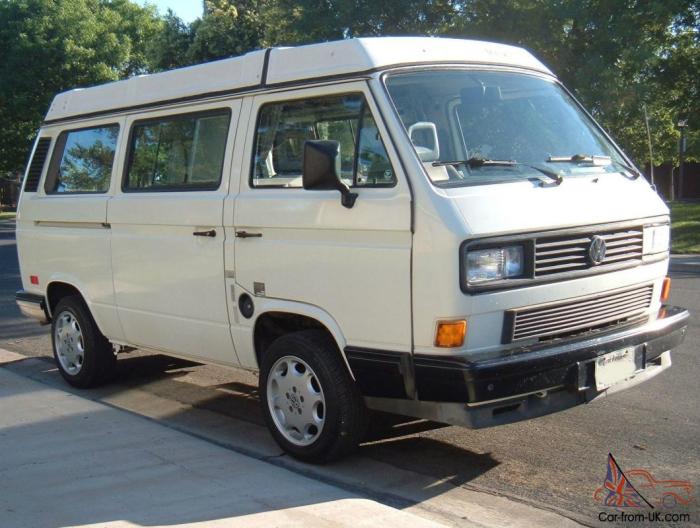
The 1988 Volkswagen Westfalia Camper continues to hold a special place in the hearts of enthusiasts, representing a bygone era of simple pleasures and unbridled freedom. Its timeless design, practical features, and enduring legacy have secured its place as a classic, captivating new generations with its charm and versatility.
As we delve deeper into the world of the 1988 Westfalia Camper, we uncover a story of innovation, craftsmanship, and a spirit of adventure that continues to resonate today.